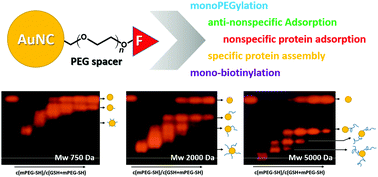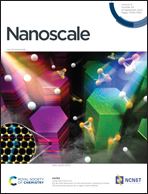From mono-PEGylation towards anti-nonspecific protein interaction: comparison of dihydrolipoic acid versus glutathione-capped fluorescent gold nanoclusters using gel electrophoresis†
Abstract
Ultrafine fluorescent gold nanoclusters (AuNCs) have emerged as biocompatible nanoprobes for biomedical imaging in vivo, and the precision surface chemistry of AuNCs is the key for attaining their clinical application. Comparison of two promising candidates for future nanomedicine, i.e. dihydrolipoic acid- versus glutathione-capped AuNCs (AuNC@DHLA vs. AuNC@GSH), was conducted for the first time to clarify their polyethylene glycol-related bioconjugate chemistry (PEGylation) and protein interactions. Gel electrophoresis was performed to separate the number of AuNCs PEGylation, and the molecular weight of the PEG spacer dominated the resolution of the separation in the gel. We have engineered and isolated the mono-PEGylated AuNCs either from the indirect carbodiimide bioconjugate chemistry or the direct Au–S binding. One-pot synthesis showed great efficiency for isolating mono-PEGylated AuNC@GSH from the tailored controlled aggregation of Au(I)–thiolate complexes on in situ generated Au(0) cores. Post-PEGylation of AuNC@GSH was also feasible using monodendate thiol-terminated PEG, but bidendate ligands of AuNC@DHLA exhibited low PEGylated efficiency by Au–S binding. In addition, mono-PEGylated AuNC@GSH significantly enhanced the ability of anti-nonspecific protein adsorption, but mono-PEGylated AuNC@DHLA cannot avoid the nonspecific binding with serum albumin. In addition, specific nano-assembly involving mono-biotinylated AuNCs with streptavidin were also compared using gel electrophoresis. These results provide key insights into the selection, preparation and design of functional AuNCs as nanoprobes for versatile biomedical applications.



 Please wait while we load your content...
Please wait while we load your content...